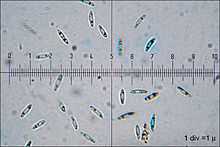Chlorociboria aeruginascens
| Chlorociboria aeruginascens | |
|---|---|
 | |
| The green elfcup, Chlorociboria aeruginascens. | |
| Scientific classification | |
| Kingdom: | Fungi |
| Division: | Ascomycota |
| Subdivision: | Pezizomycotina |
| Class: | Leotiomycetes |
| Order: | Helotiales |
| Family: | Helotiaceae |
| Genus: | Chlorociboria |
| Species: | C. aeruginascens |
| Binomial name | |
| Chlorociboria aeruginascens Kanouse ex C.S. Ramamurthi, Korf & L.R. Batra (1957) | |
| Synonyms | |
|
Chlorociboria aeruginascens | |
Chlorociboria aeruginascens is a saprobic species of mushroom, commonly known as the green elfcup[1] or the green wood cup[2] because of its characteristic small, green, saucer-shaped fruit bodies. Although the actual fruit bodies are infrequently seen, the green staining of wood caused by the fungus is more prevalent.
Taxonomy
The specific epithet is derived from the Latin roots aerug- ("blue-green") and ascens ("becoming").[3] Some authors have used a variant spelling of the specific epithet, aeruginescens.[4][5][6]
Description


This species has apothecia (cup-shaped ascocarps) that are usually attached laterally, often less than 0.5 cm in diameter, collapsing laterally and becoming rolled inwards when dry. The outer tissue layer of the apothecium, known as the ectal excipulum, has a delicate tomentose surface composed of hair-like, straight or sometimes coiled, smooth hyphae. The stipe is typically less than 3 mm long, with a central or eccentric attachment to the apothecia. Spores are roughly spindle-shaped (fusiform), smooth, and 5–8 by 0.7–2.8 µm.[7] Apothecia grow on bark-free wood, especially oak, part of which at least is stained greenish by the mycelium. The abundant paraphyses, which may be entwined, are 55–95 by 1.5–2 µm, filiform, and septate with an unswollen, unbent apex that often extends beyond the level of the asci tips.[8]
The species is distinguished from the closely related C. aeruginosum by having smaller spores. Although some authors have in the past failed to recognize any appreciable differences between the two species,[4][5][9] Ramamurthi and colleagues note[7] that not only are the spore sizes different, but C. aeruginascens have smooth tomentum hyphae, in contrast with the roughened hyphae of C. aeruginosum.
"Green oak"

This species contains a quinone pigment called xylindein,[10][11] a dimeric naphthoquinone derivative, whose structure was determined by spectroscopic means in the 1960s [12] and later confirmed by X-ray crystallography.[13] It is this compound that is responsible for the characteristic bluish-green stain of wood infected by this species, used today in decorative woodworking such as Tunbridge ware[14] and parquetry.[15] The use of this wood, known as "green oak", goes back to 15th century Italy, where it was used in intarsia panels made by Fra Giovanni da Veroni.[16]
References
- ↑ "Rogers Mushrooms | Mushroom Pictures & Mushroom Reference". Retrieved 2008-12-08.
- ↑ "Borescope-Chlorociboria aeruginascens". Retrieved 2008-12-09.
- ↑ "Chlorociboria aeruginascens". Retrieved 2008-12-09.
- ↑ 4.0 4.1 Seaver FJ. (1936). Photographs and descriptions of cup-fungi-XXIV. Chlorociboria. Mycologia 28: 390–394.
- ↑ 5.0 5.1 Seaver FJ. (1951). The North American Cup-Fungi (Inoperculates). New York. Pp. 1–428.
- ↑ Velenovský J. (1934). Monographia Discomycetum Bohemiae. 1: 1–436. 2: pl. 1–31. Prague.
- ↑ 7.0 7.1 Ramamurthi CS, Korf RP, Batra LR. (1957). A revision of the North American species of Chlorociboria (Sclerotiniaceae). Mycologia 49(6): 854–863.
- ↑ Fungi of Southern Australia - Google Book Search. Retrieved 2008-12-09.
- ↑ Dennis RWG. (1956). A revision of the British Helotiaceae in the herbarium of the Royal Botanic Gardens, Kew, with notes on related European species. Commonwealth Myc. Inst. Myc. Papers 62: 1–216.
- ↑ Schmidt O. (1994). Holz- und Baumpilze. Biologie, Schiden, Schutz, Nutzen. Berlin/Heidelberg. pp 92–93.
- ↑ Maeda M, Yamauchi T, Oshima K, Shimomura M, Miyauchis, Mukae K, Sakaki T, Shibata M, Wakamatsu K. (2003). Extraction of Xylindein from Chlorociboria aeruginosa complex and its biological characteristics. Technical report of the Technological University of Nagaoka 25: 105–111.
- ↑ R. L. Edwards and N. Kale, Tetrahedron 1965, 21, 2095–2107
- ↑ Saikawa Y, Watanabe T, Hashimoto K, Nakata M. (2000). Absolute configuration and tautomeric structure of xylindein, a blue–green pigment of Chlorociboria species. Phytochemistry 55(3): 237–240.
- ↑ Arora, David (1986). Mushrooms Demystified: A Comprehensive Guide to the Fleshy Fungi. Ten Speed Press. p. 959. ISBN 0-89815-169-4. Retrieved 2008-12-09.
- ↑ Wickens, G.E. (2004). Economic Botany: Principles and Practices. Springer. p. 566. ISBN 1-4020-2228-X. Retrieved 2008-12-09.
- ↑ Blanchette RA, Wilmering AM, Baumeister M. (1992). The use of green-stained wood caused by the fungus Chlorociboria in intarsia masterpieces from the 15th century. Holzforschung 46(3): 225–232.
External links
| Wikimedia Commons has media related to Chlorociboria aeruginascens. |